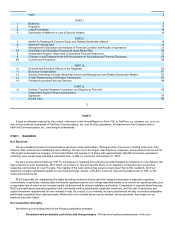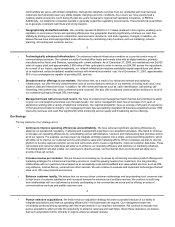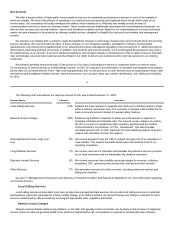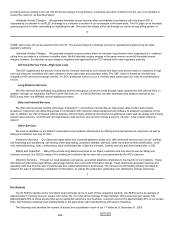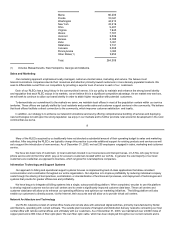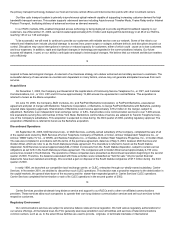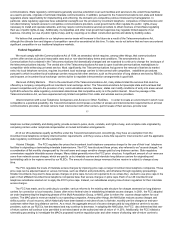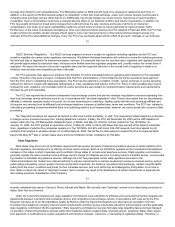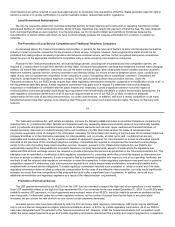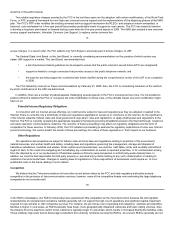FairPoint Communications 2003 Annual Report Download - page 12
Download and view the complete annual report
Please find page 12 of the 2003 FairPoint Communications annual report below. You can navigate through the pages in the report by either clicking on the pages listed below, or by using the keyword search tool below to find specific information within the annual report.
faced with the threat of significant competition. In fact, we have virtually no wireline competition in any of our RLEC markets.
In most of our rural markets, we face competition from wireless technology. We do not expect this technology to represent a significant
competitive threat to us in the near term, but as technology and economies of scale improve, we may experience increased competition from
wireless carriers. We also face competition from new market entrants, such as cable television and electric utility companies. Cable
television companies are entering the telecommunications market by upgrading their networks with fiber optics and installing facilities to
provide fully interactive transmission of broadband voice, video and data communications. However, we believe that the unfavorable
economics of constructing and operating competitive systems in our sparsely populated areas and the difficulties inherent in selling such
services to a predominantly residential customer base has resulted in limited competition from cable service providers. Electric utilities have
existing assets and access to low cost capital that could allow them to enter a market rapidly and accelerate network development. In addition,
in the future, we may face additional competition from new market entrants, such as providers of wireless broadband and voice over internet
protocol.
The Internet services market is also highly competitive, and we expect that competition to continue to intensify. Internet services,
meaning both Internet access (wired and wireless) and on-line content services, are provided by Internet service providers, satellite-based
companies, long distance carriers and cable television companies. Many of these companies provide direct access to the Internet and a
variety of supporting services to businesses and individuals. In addition, many of these companies, such as America Online, Inc., Microsoft
Network and Yahoo, offer on-line content services consisting of access to closed, proprietary information networks. Long distance companies
and cable television operators, among others, are aggressively entering the Internet access markets. Long distance carriers have substantial
transmission capabilities, traditionally carry data to large numbers of customers and have an established billing system infrastructure that
permits them to add new services. Satellite companies are offering broadband access to the Internet from desktop PCs. Many of these
competitors have substantially greater financial, technological, marketing, personnel, name-brand recognition and other resources than
those available to us.
In addition, we could face increased competition from CLECs, particularly in offering services to Internet service providers.
As of December 31, 2003, we employed a total of 831 full-time employees. 126 employees of our RLECs are represented by four
unions. We believe the state of our relationship with our union and non-union employees is good. Within our Company, 33 employees are
employed at our corporate office, 790 employees are employed at our RLECs and 8 employees are employed by Carrier Services.
We own all of the properties material to our business. Our headquarters is located in Charlotte, North Carolina. We also have
administrative offices, maintenance facilities, rolling stock, central office
17
and remote switching platforms and transport and distribution network facilities in each of the 17 states in which we operate our RLEC
business. Our administrative and maintenance facilities are generally located in or near the rural communities served by our RLECs and
our central offices are often within the administrative building and outlying customer service centers. Auxiliary battery or other non-utility
power sources are at each central office to provide uninterrupted service in the event of an electrical power failure. Transport and distribution
network facilities include fiber optic backbone and copper wire distribution facilities, which connect customers to remote switch locations or to
the central office and to points of presence or interconnection with the long distance carriers These facilities are located on land pursuant to
permits, easements or other agreements. Our rolling stock includes service vehicles, construction equipment and other required
maintenance equipment.
We believe each of our respective properties is suitable and adequate for the business conducted therein, is being appropriately used
consistent with past practice and has sufficient capacity for the present intended purposes.
We currently and from time to time are involved in litigation and regulatory proceedings incidental to the conduct of our business, but
currently we are not a party to any lawsuit or proceeding which, in our opinion, is likely to have a material adverse effect on us.
No matters were submitted to a vote of our security holders during the fourth quarter of the fiscal year.
18


